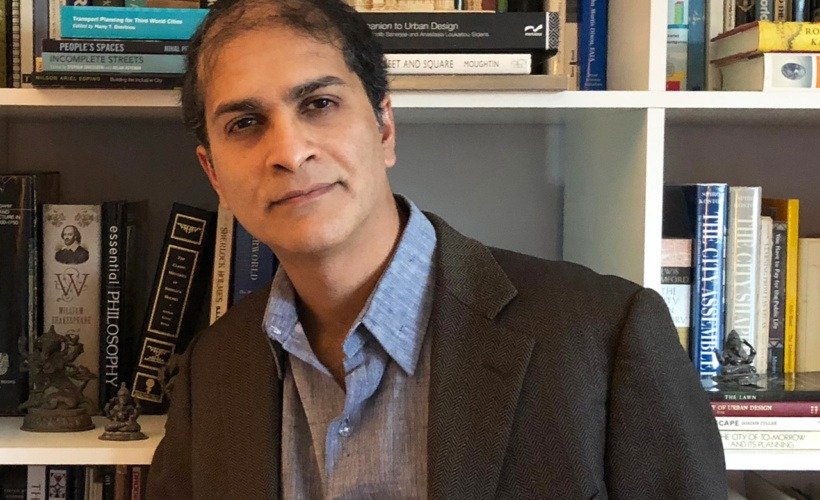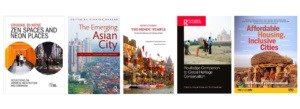
Vinayak Bharne is Principal and Director of Design at the influential Los Angeles architecture and planning firm, Moule & Polyzoides. He is also Adjunct Associate Professor of urbanism at the University of Southern California; Director of the India-Netherlands-based knowledge platform, My Liveable City; and the author/editor of five books on architecture and urbanism
My education
I studied at Sharada Mandir, and the T.B Cunha Govt. Higher Secondary, before joining Goa College of Architecture. In my third year, I won a national public speaking contest, got a scholarship to go to Japan, and this trip was an education in itself. I applied to graduate schools in the US and Canada, and was lucky enough to get a scholarship from the University of Southern California (USC). I finished my Master’s degree, and received a year-long fellowship at the Marshall School of Business to train in leadership and this changed my outlook towards how to practice and why.
Why I chose architecture for higher learning
I actually studied urban design and city planning during my graduate school. By the time I finished my B Arch, I had developed an intrigue for cities. My stay in Tokyo had a lot to do with this. Why are cities so different? What do they mean for the future of our planet? How is architecture related to city making? The challenges of urban poverty and environmental degradation had begun to bother me. I was more interested in these questions, than creating cool buildings, though I was unclear what I was looking for.
Important influences on my career
My father has been my public speaking coach, so his influence on my career goes without saying. On the architectural side, there are two individuals. Bruno Dias Souza (94) was one of India’s foreign-educated, post-independence era architects, like Achut Kanvinde and Charles Correa. Bruno studied architecture at Harvard in the 50s, had an illustrious global career, and retired in Goa. In my four years with him, you can say that my eyes were opened to the highest standards of architecture. Then at USC, one of my professors was the noted urbanist Stefanos Polyzoides. He opened my eyes to the world of urbanism and invited me to join his distinguished practice, where I am Principal today. Whatever little I am, it is because of these giants.
Some projects that make me happy…
I have learnt to gauge my work less through what I have accomplished, and more through what impact it has made to the life of others. In this regard, a few projects that stand out. Lancaster Boulevard was a low-budget redesign for a mile-long dilapidated street in California, which transformed the economic destiny of an entire city. Last year, I helped design a neighborhood for one of the poorest African-American communities in the US. When we finished the master plan, there were literally tears of joy and hope in the community, something that I had never experienced before. At Del Mar Station, we brought high density housing around a train station for the first time in Los Angeles, to incentivize dependence on public transit rather than cars. In Panama, we are in the process of changing the entire country’s street standards to make them more pedestrian – and environmentally-friendly. In the US, we have rewritten FSI zoning rules to reform development trends. This may all sound banal and boring, but for me, it is far more consequential than any single cool looking building I have designed.
My recent trip to Goa
My most recent trip in May was very special because it was centered on two back-to-back public lectures. One was at the Sunaparanta Center for the Arts, where I spoke about my two recent books. The other was at Ravindra Bhavan in Margao, where I was invited to give a keynote on planning for Goa, on the occasion of the 2019 Goa Heritage Festival. I met some very influential people at both events, which is always a good thing.
The books that I have authored
The two most recent ones are a 30-chapter edited anthology “Routledge Companion to Global Heritage Conservation,” and a 36-chapter edited volume “Affordable Housing, Inclusive Cities.” They are an effort to learn more about two topics that continue to bother me: The loss of heritage, cultural and ecological. And the socio-economic inequality that plagues our cities. What can I do about this as an architect and urbanist?

My impression about the architecture profession in Goa
There has never been a shortage of architectural talent in Goa. There are so many remarkable architects who are doing, or are capable of doing wonderful buildings. I know many of them, and hold them in the highest regard.
There are two issues I see. One is that there is no robust planning and urban design agenda, or even knowledge. A beautiful place like Goa needs this urgently, otherwise you will get a bunch of “cool” buildings thrown here and there, without amounting to anything.
The other problem is the petrified administrative system and bylaws within which all Goan architects have to work. So even if they have the right intentions about urban design, conservation etc., the system does not let them go too far.
So what I learnt is that in Goa, architectural talent is as much about design as it about knowing how to navigate this administrative ecosystem. Some Goan architects are great at design but not at navigation. Others are naturals at navigation but horrible designers. My hope is that each will learn from the other.

What keeps me busy currently
I am doing projects across a few continents right now, so there is constant travel to and from the US. I teach twice a week, and my students keep me updated about the world. I am contemplating a book on streets in India. And as Director of the India-Netherlands-based knowledge platform, My Liveable City, I have to teach executive courses each summer in Europe and produce four magazines a year. But amidst all this, my wife and children keep me centered, and grounded. And believe me, not a day goes by when I do not dream about doing a project in Goa
Ar. Sidharth Naik installed Chairman of IIID-Goa
The installation ceremony of the managing committee for the term 2019-21 of the Institute of Indian Interior Designers – Goa Centre (IIID-Goa) was held at Laranja, Cidade de Goa on Friday, 9th August 2019. The Institute of Indian Interior Designers, popularly known as the IIID was founded in 1972 to establish good professional and trade practices and ethics amongst its members; and to highlight and enhance the image of the interior design profession and exchange know-how with similar organisations within the country and abroad. IIID is a member of Asia Pacific Space Designers Alliance (APSDA). Today, with over 8,000 members in 28 chapters and centres across India, IIID is a true representative of the interior design fraternity within the country as well as globally.
The young and dynamic Architect Sidharth Naik was installed as Chairman of IIID-Goa. The other office bearers as under: Ar. Sumedh Naik (Hon. Secretary), Ar. Rajesh Kenkre (Hon. Treasurer), Ar. Krishna Phaldesai (Chairperson-elect), Pravin Pai Lotlikar (Vice chairperson), Ar. Snehalata Pednekar (Immediate Past Chairperson), Ar. Siddha Sardessai, Ar. Siddharth Deshpande, Ar. Pallavi Satardekar, Ar. Rahul Sardessai (MC members). Ar. Ashley Mascarenhas and Keyur Desai are co-opted to the managing committee.
Founder Chairperson of IIID-Goa, Ar. Rita Mody Joshi administered the oath of office. Ar. Sidharth Naik spoke about IIID-Goa and its endeavours to undertake projects and events which will educate the general public about good design, elevate the use of public and private spaces with design interventions and build camaraderie among the design fraternity in order to create a ‘Design Think-Tank’.
Ar. Rajnish Hedao, a renowned production designer from Mumbai who has been associated with films like 3 idiots, PK, Bhag Milkha Bhag and many more was the Chief Guest for the function that was well attended by over 100 members of interior design fraternity. As part of the keynote address, Ar. Hedao shared an enlightening and entertaining presentation of his journey.
Outgoing Chairperson Ar. Snehalata Pednekar spoke about the highlights of term 2017-19 while Outgoing Hon. Secretary Ar. Krishna Phaldesai placed the activity report. Hon. Secretary Ar. Sumedh Naik proposed the vote of thanks.
Ar. Siddha Sardessai and Fauzia Khan compered the show. The event was sponsored by Mitsubishi Electric Air Conditioners





